Je kunt nu in World of Warcraft raiden in je eentje
Het bericht Je kunt nu in World of Warcraft raiden in je eentje verscheen eerst op DutchCowboys.
Het bericht Je kunt nu in World of Warcraft raiden in je eentje verscheen eerst op DutchCowboys.
Het bericht Netflix Games Review: Snake.io maakt ons weer even kind verscheen eerst op DutchCowboys.
Het bericht De Epic Games Store is nu op iPad beschikbaar verscheen eerst op DutchCowboys.
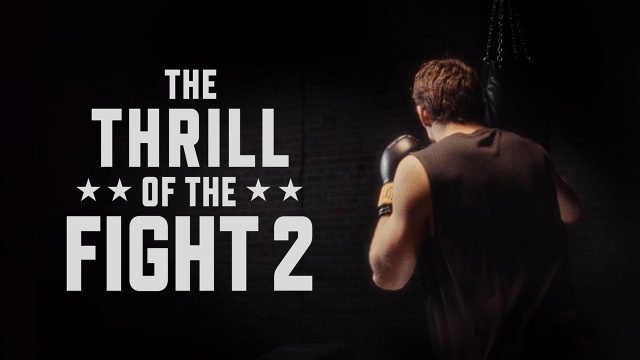

Thrill of the Fight 2, the upcoming sequel to Quest’s most popular VR boxing sim, seems to be gearing up for release, as studios Sealost Interactive and Halfbrick Studios tossed out its first teaser trailer.
Update (September 16th, 2024): Announced early last year, we’re still waiting on gameplay, although the studios are chumming the waters now with a new live-action teaser, stating to “Prepare Yourself.”
The game is coming to Quest first, however original creator Ian Fitz says the team plans to bring it to other platforms eventually, which he notes isn’t due to “any contractual exclusivity or anything like that.”
Additionally, Fitz notes the Sealost Interactive team officially started work on Thrill of the Fight 2 in July 2020, but scaling the studio was an issue. “I abandoned that [internal scaling] plan and started working with Halfbrick, and we restarted the project together in January 2023,” Fitz says in a Discord post.
There’s no release date yet, however Fitz says we’ll find out “soon! ! and I mean soon!” The original article detailing the initial reveal and Halfbrick’s involvement follows below:
Original Article (January 23rd: 2023): Created by Ian Fitz and his studio Sealost Interactive in 2016, Thrill of the Fight focuses on realistic boxing mechanics, eschewing arcadey things like stamina bars and unrealistic knockout blows.
Thrill of the Fight 2, which is now in co-development by Halfbrick Studios, is bringing the much-requested feature of multiplayer mode. In a development update video (below), Halfbrick CEO Shainiel Deo reveals a few more features coming to the sequel: improved audio and visual feedback, changes to how combinations are scored, more gameplay variety to keep players coming back for more.
Halfbrick is known for developing both the flatscreen versions of Fruit Ninja and Fruit Ninja 2 and also their respective VR adaptations. The studio’s bread and butter however has been its slew of mobile games, including Jetpack Joyride, Battle Racing Stars, Dan the Man, and Shadows Remain.
In an update posted to Reddit by Sealost Interactive, series developer Ian Fitz discusses Halfbrick’s involvement.
“The reason I’m partnering up with Halfbrick on this is because I was comfortable it would help make the game I wanted to make. They want to make (and play) the same game I do,” Fitz says.
Fitz also broke down the division of labor, and how the sequel is being made in cooperation with Halfbrick.
“I made the blueprint. Sealost prototyped and proved out many of the mechanics and tech challenges. Halfbrick is putting together a release-worthy product and supporting it into the future. I’m in meetings with them every workday building the product right alongside them and making sure we don’t deviate from the original plan (which hasn’t been a problem because, again, they want to make the same game I do).”
Fitz notes the partnership with Halfbrick “doesn’t have anything to do with funding. This is just about having a solid production team and a plan in place to support the game post-launch.”
The studios say they’re aiming for release “later this year,” although that’s admittedly “just an estimate based on current progress,” Fitz says.
It’s still unclear which platforms are initial targets, however if the original is any indications, we’re liable to see it on Quest 2/Pro, Steam VR, and possibly also PSVR 2.
The post Sequel to Quest’s Most Popular VR Boxing Game Teases Release in New Trailer appeared first on Road to VR.

Wie vroeger games kocht, kocht een floppy of een cd-rom waar het spel op stond. Na betalen en installeren was de game van jou en kon je het spelen wanneer je wilde. Zelfs als de maker van het spel failliet ging of de maker niet meer aan het spel wilde werken, kon jij de game blijven spelen. Tegenwoordig is dat anders. Nu games vaak online componenten hebben of alleen digitaal beschikbaar zijn, kan een maker besluiten de ondersteuning te stoppen, waardoor jij het niet meer kunt spelen. Stop Killing Games wil daar een stokje voor steken. In Nederland blijkt daar wel animo: het vereiste aantal handtekeningen is behaald, meldt Tweakers.
Stop Killing Games ontstond na een incident rondom het spel The Crew, schrijft de organisatie op zijn website. The Crew was een online racespel van Ubisoft, dat in 2014 op de markt verscheen. Eerder dit jaar besloot Ubisoft echter om de servers te sluiten, met als gevolg dat niemand het spel dus nog kon spelen. Volgens Stop Killing Games had het spel op dat moment minstens 12 miljoen spelers.
De organisatie, gestart door Ross Scott, zag dit als een mooie kans om te protesteren. Enerzijds door de Franse marktautoriteiten – Ubisoft is een Frans bedrijf en valt dus onder hun toezicht – op de hoogte te stellen, in de hoop dat zij een rechtszaak starten, wat er mogelijk weer voor zorgt dat andere uitgevers wel twee keer nadenken voor ze een server sluiten. Anderzijds met petities naar overheden wereldwijd, waarin ze opgeroepen worden om wetgeving te maken die ervoor zorgt dat games altijd ‘in redelijke staat’ beschikbaar blijven.
In het geval van The Crew zou dat volgens het initiatief betekenen dat gamers kunnen blijven racen, al zijn misschien niet alle functies beschikbaar, weet Tweakers. Mogelijk zijn er geen leaderboards meer of vervalt de virtuele marktplaats, maar de kern van het spel – racen – blijft bestaan.
Stop Killing Games wil met zijn Europese petitie zorgen dat de Europese Commissie het voorstel behandeld en zich dus gaat buigen over het al dan niet maken van wetgeving om games beschikbaar te houden. Wil het initiatief dat bereiken, dan moet het in ten minste zeven EU-lidstaten een vooraf bepaald minimumaantal handtekeningen verzamelen én in totaal minstens een miljoen handtekeningen binnenhalen.
Op het moment van schrijven heeft de petitie 346,540 handtekeningen in Europa. Daarnaast is het minimumaantal in een aantal lidstaten al behaald, waaronder dus Nederland. In ons land waren minstens 20.000 stemmen nodig. Verder is in Denemarken, Duitsland, Polen, Zweden en Finland het minimumaantal handtekeningen binnengehaald. De petitie heeft tot 31 juli 2025 om de minimumaantallen te halen.
Als alles goed gaat en de handtekeningen zijn goedgekeurd door de desbetreffende overheden, krijgen de initiatiefnemers drie maanden de kans om hun ideeën voor te dragen aan de Europese Commissie en het Europees Parlement. De Commissie krijgt vervolgens een halfjaar om te bepalen of het daadwerkelijk actie gaat ondernemen. Het duurt dus nog wel even voor we daadwerkelijk weten of er een wetsvoorstel komt.
Lees Initiatief om games permanent beschikbaar te houden haalt voldoende Nederlandse stemmen verder op Numrush
Het bericht De eerste Mario Kart LEGO-set bevat Lakitu verscheen eerst op DutchCowboys.
Het bericht Twitch wordt duurder in de mobiele app verscheen eerst op DutchCowboys.

De Borderlands-reeks krijgt binnenkort een nieuwe game. 2K Games en Gearbox Software hebben aangekondigd dat Borderlands 4 in 2025 op de markt verschijnt.
De Borderlands-games zijn first-person looter-shooters, die qua stijl zowel binnen de westerns als de sci-fi-games thuishoren. De reeks bevat al zes spellen: naast de drie mainline games zijn er ook spin-offs als Tiny Tina’s Wonderlands en Tales from the Borderlands.
Borderlands 4 wordt het zevende spel in de reeks en de vierde mainline-titel. Deze game speelt zich op een geheel nieuwe planeet af, waar je opnieuw een legendarische Vault Hunter bent. Doel is om schatten te vinden en alles in zicht op te blazen. Veel meer details zijn nog niet bekend, maar maker Gearbox laat wel weten dat er enorme ambities zijn. “We zetten alles op alles om alles wat we leuk vinden aan Borderlands beter te maken dan ooit tevoren, terwijl we de game naar een nieuw niveau tillen en spannende nieuwe richtingen opgaan”, zegt Randy Pitchford, oprichter en president van Gearbox Entertainment Company.
De game verschijnt in 2025 op PlayStation 5, Xbox Series X|S en op PC via Steam en de Epic Games Store. De precieze releasedatum voor het spel is nog niet bekendgemaakt.
Borderlands 4 is de eerste game in de reeks die ontwikkeld wordt na de overname van Gearbox Entertainment. De gamemaker werd eerder dit jaar gekocht door Take-Two Interactive, waar 2K Games ook onder valt, zo meldde Tweakers destijds. De eerdere Borderlands-spellen werden echter ook al door 2K uitgegeven, dus in dat opzicht verandert er weinig.
Lees Borderlands 4 verschijnt in 2025, eerste teaser is nu te zien verder op Numrush
Het bericht HEMA is nu ook aanwezig in Fortnite met SLAYMA verscheen eerst op DutchCowboys.
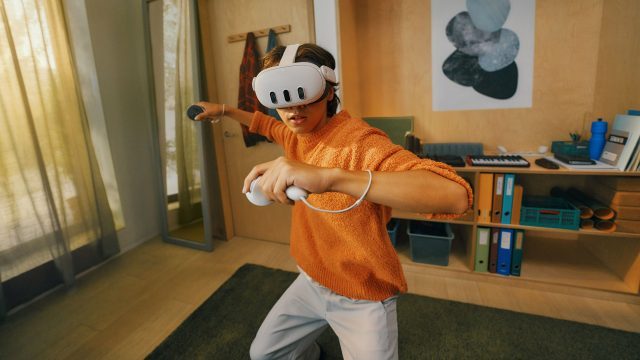

Not ready to plonk down your first $100 on Quest games? Thankfully there’s an impressive number of free games, experiences, apps, and social VR platforms to keep you playing before you’re paying—all of them compatible with Quest 2, Quest Pro, and Meta’s latest, Quest 3.
Looking to make your Quest 3 gaming experience even better? Don’t miss our top picks for the most essential Quest 3 accessories.
As a Yeep, your belly is full of stuffing used to craft anything from pillows for building to bombs for destruction. Pull items from your vast imagination and toss them into the world. The game’s intuitive block-based building makes it easy to express your creativity at any skill level.
Step on the podium and become a true orchestra conductor in Maestro: The Masterclass. Play hands free or grab a chopstick and master the real hands motions that command the orchestra through an off the rail conducting masterclass that culminates with an epic symphonic concert in a packed opera house. Good luck, Maestro!
Like your primitive ancestors, Gorilla Tag will have you lumbering around a tree-lined arena using its unique ‘grab-the-world’ locomotion style that lets you amble around like a great ape. Chase the other apes and infect them or climb for your life as the infected chase you. Pure and simple. Make sure you’re far from TVs, furniture, babies, and pets because you will punch something in the mad dash for sweet, low-poly freedom.
Riding off the success of cult-like status of ‘The Backrooms’ Internet lore, Noclip VR lets you and online players explore the liminal spaces, solve puzzles, and escape that which lurks within. To move, you’ll need to swing your arms, and always keep in ear-shot of your friends, otherwise they won’t hear you scream. Gameplay is a bit barebones, making it feel more like something you’d find imported on a social platform like VR Chat or Rec Room, although it’s definitely invoking Gorilla Tag vibes.
Population: One is basically VR’s most successful battle royale, letting you climb, fly, shoot, and team-up with whoever dares. The free-to-play game does feature microtransactions, but only for cosmetics, which is nice. It’s more than just a battle royale though: you can play in the sandbox for custom maps and rules, team deathmatch with customizable loadouts, a 12v12 war mode, and more.
Gun Raiders serves up a healthy slice of multiplayer shooter action with multiple game modes that let you jetpack through the air, climb from wall to wall, and shoot down the competition. There’s the same sort of microtransactions you see in bigger games, but it they’re all avatar skin stuff, so no pay-to-win here.
Gym Class – Basketball is the solution if you’re looking to shoot some hoops and dunk like you probably can’t on a physical court. Online multiplayer lets you go head-to-head for a pretty convincing game of b-ball thanks to the game’s physics-based and full-body kinematics.
This room-scale shooter is now free-to-play, letting you take on friends, family and foes in head-to-head 1v1 dueling. Refine your loadout and jump into the action as you scramble for weapons and send a volley of hellfire at your enemies, all the while Matrix dodging through this innovative bullet hell meets futuristic dueling game.
Hyper Dash is a multiplayer shooter that basically fills in where Echo Combat never could (never mind that Echo Combat was never on Quest, and is now entirely defunct on Oculus PC). Letting you quick dash, sprint, and rail grind around, Hyper Dash manages to serve up an impressive number of modes, including Payload, Domination, Control Point, (Team) Deathmatch, Capture The Flag, and Elimination. You can also take on both Quest and SteamVR users thanks to the inclusion of cross-play.
Ultimechs should look pretty familiar: it’s basically Rocket League, but instead of driving around in cars, you’re given rocket-powered fists to punch balls into the goal. Online multiplayer includes both 1v1 and 2v2 matches, offering up tons of opportunities to earn cosmetic gear that will let you outfit your battle mech into something unique. There are also now two paid battle passes too, offering up a ton of cosmetics to set you apart from the competition.
Battle Talent is one of those fighting sims that let you go ham on ragdoll baddies, which in this case are wily goblins and loads of skelingtons. This physics-based roguelite action game lets you climb, run and slide your way through levels as you slash, shoot, and wield magic against your foes.
Cards & Tankards is a pretty addictive social collectible card game, letting you collect and battle friends with over 180 cards. With cross-play against SteamVR headsets (also free on PC), you may consider hosting your regular game night playing more than a few rounds in the game’s characteristic medieval fantasy tavern.
No real cash gambling here, but PokerStars’ Vegas Infinite not only let you go all-in on games of Texas Hold’em, but now a full casino’s worth of table games a machines that are sure to light up the dopamine starved pleasure centers of your brain. It’s all free play, so you won’t be risking real cash unless you buy in-game chips, which cannot be turned back into real money: it’s only to keep your bankroll flush for free play.
Since the Fishin’ Buddies update, this classic VR title has gotten a whole new lease on life as a multiplayer VR fishing game that lets you sit back and crack a cold one with the boys as you reel in the big’uns. The additional social areas also let you sit back between your fishing adventures to take part in casual mini-games.
Gods of Gravity is an arcade-style RTS game where you compete in an epic showdown of between celestial gods (2-8 players). Scoop up ships and fling them to capture a nearby planet, or open wormholes to teleport them across the solar system. Hold planets and moons to boost your production. Mine asteroids for the powerful resources within. And if you dare, capture the sun for the ultimate buff. Then send a massive fleet to conquer your enemy’s home planet. Last god standing wins.
Without a doubt one of the most fun, and most expansive VR titles out there… and it’s free. Sure, you can pay real cash for in-game tokens to buy spiffy clothes for your avatar, but that’s really up to you. Gads of mini-games await you in both first-party creations such as the ever so popular co-op Quests—that could be games in their own right—to user-created stuff that will keep your pocket book gathering dust. It’s social VR, so meet people and have a ball for zero dollarydoos. Fair warning: there’s a ton of kids.
If you’ve been anywhere near the Internet in the last few years, it’s likely you’ve already heard about VRChat, the user-generated social VR space filled with… well… everything you can imagine, re-pro games included like Among Us, Mario Kart, and even a version of Beat Saber. Fashion your own avatar or download the millions of user-generated avatars out there so you can embody SpongeBob, Kirito from Sword Art Online, or any one of the million anime girl avatars that you’re bound to see there.
Horizon Worlds has changed a lot since launch. It now includes more tools, user-generated content, and some more compelling first-party games which has rounded out things to make it more competitive with Rec Room and VRChat. You may want to check in just to see the state of Meta’s first-party VR social platform. Whatever the case, the price of ‘free’ is hard to argue with.
The post 25 Free Games & Apps Quest 3 Owners Should Download First appeared first on Road to VR.

Camai! You walk through a beautiful forest, listening to the nearby stream, and settle by the campfire, while your grandfather and a bear await you by the waterfall. After fishing with your grandfather, you carefully cross the stream and start collecting berries for the bear. Your adventures in the game Nunaka have just begun.
Created with Chugachmiut, a non-profit that serves Native tribes in the Chugach region of Alaska, Nunaka is an early childhood mobile game that excites 3-5-year-olds about the Alaska Native Sugpiaq culture, teaches the Sugt’stun language, and targets key school readiness goals. The game recently won the Formal Learning (Elementary) award at the James Paul GEE! Learning Game Awards.
In the story-driven game, players take on the role of a Sugpiaq child living with their grandparents, Emaa and Apaa, in a fictionalized version of a community based on villages in the Chugach region. Players create an avatar and explore the village, completing activities and minigames, while collecting items and interacting with other residents, including human characters and animals from the region.
Nunaka is now available as a mobile app in the App Store and Google Play for phones and tablets. Nunaka from FableVision Studios is a Cool Tool Award Winner for “Best New Product or Service” as part of The EdTech Awards 2024 from EdTech Digest. Learn more.
The post Nunaka from FableVision Studios appeared first on EdTech Digest.
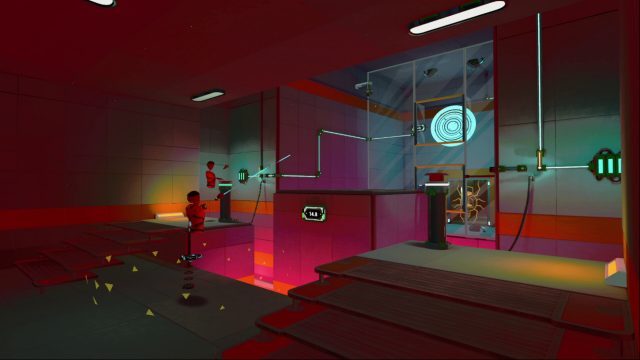
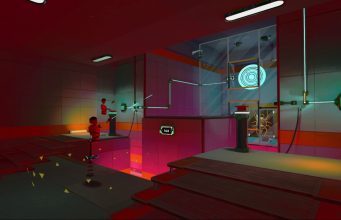
Indie studio Ivory Crow Games have released a new demo for Chrono Weaver, a single player game that lets you make copies of yourself to solve physics-based puzzles.
Set in a mysterious science facility filled with mind-bending puzzles, you use your trusty slingshot and time travel device to find solutions to seemingly impossible tests.
If you’ve noticed a few familiar influences in the new trailer, you’re not wrong. Here’s how the studio described Chrono Weaver to Road to VR:
In our game you play as a test-subject starting a new job, with unknown origins and a simple goal: Smash the Data Disk. Guiding you along the way is a flying robot named Yoto, a quirky character who manages your journey and helps make sure you don’t get too lost along the way.
The gameplay loop has a vibe similar to Portal, going from puzzle to puzzle with short bursts of story and mystery in between. The game teaches as you go along, so there is no true tutorial, instead it grows in difficulty, introducing mechanics and weaving them together creating exciting and challenging puzzles. Other games that are similar to it in VR are The Last Clockwinder, We Are One, and Transpose VR.
While there’s no release date yet, the two-person indie studio has released a demo that shows off a good slice of the game’s time-bending fun. Notably, this is a completely overhauled demo from the one distributed during Steam VR Fest back in December.
The demo is said to take between 30 minutes and an hour long to complete, which you can download for free for both Quest 2/3/Pro and SteamVR headsets. If you already played the original demo from December, the studio says you’ll need to replay it from the top, as saves don’t carry over.
Still, the studio says that with all the changes “it is basically a brand new experience so we think you will enjoy it.”
The post New ‘Chrono Weaver’ Demo Brings More ‘Portal’ Inspired Puzzling to Quest & PC VR appeared first on Road to VR.
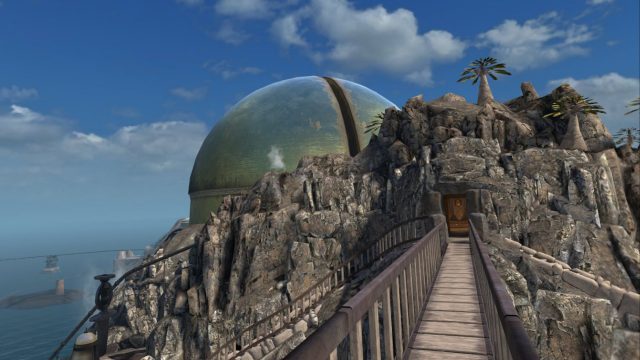
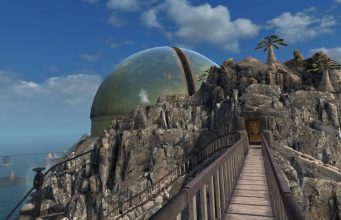
RIVEN (1997), the sequel to iconic point-and-click puzzle-adventure MYST (1993), just got the VR treatment in its new remake. Unlike Myst, which felt a little too game-y and obtuse at times, Riven plays a lot more like a modern title, which thanks to Quest and SteamVR support, is true in every sense of the word now. Granted, you’ll need to look past some VR implementation issues which keep it from feeling like a ground-up VR native, although however you play, you’ll be exploring a fascinating world that’s both puzzle-dense and undeniably beautiful at every turn.
RIVEN Details:
Available On: Quest 2/3, SteamVR
Reviewed On: Quest 3, Quest 3 via Link
Release Date: June 25th, 2024
Price: $35
Developer: Cyan Worlds
I know Riven pretty well by now, having shuffled my way around its five PlayStation 1 discs a number of times as a kid. This is the first time popping back in as an adult though, so I kind of get the chance to not only relive a bit of the past, but rediscover puzzles long forgotten, this time in the immersive first-person view of a VR headset.
While I really can’t stop nostalgia coloring some of my experience with the new 3D-rendered Riven, I’ve spent enough time in VR to know where things fit on the VR-port-continuum. Some games feel unnecessarily forced into working with VR, some are indistinguishable from VR-natives, and somewhere in the middle are great games that still feel like ports, but that’s okay because they bring enough to the table on their own. That’s where Riven sits—great game that works pretty ok in VR.
If you’re playing it for the first time, you’re in for a patently Cyan experience of deciphering codes, shuffling puzzle pieces around, and visiting (and possibly re-re-revisiting) places, doors, and enigmatic set pieces to figure out the world around you. That’s reason enough to play if you’ve never had the chance. Riven’s puzzle can be tough for the uninitiated, but ultimately more rewarding than Myst thanks to its heaps of environmental storytelling that feels less formulaic, and a lot more organic. More on that in the Immersion section.
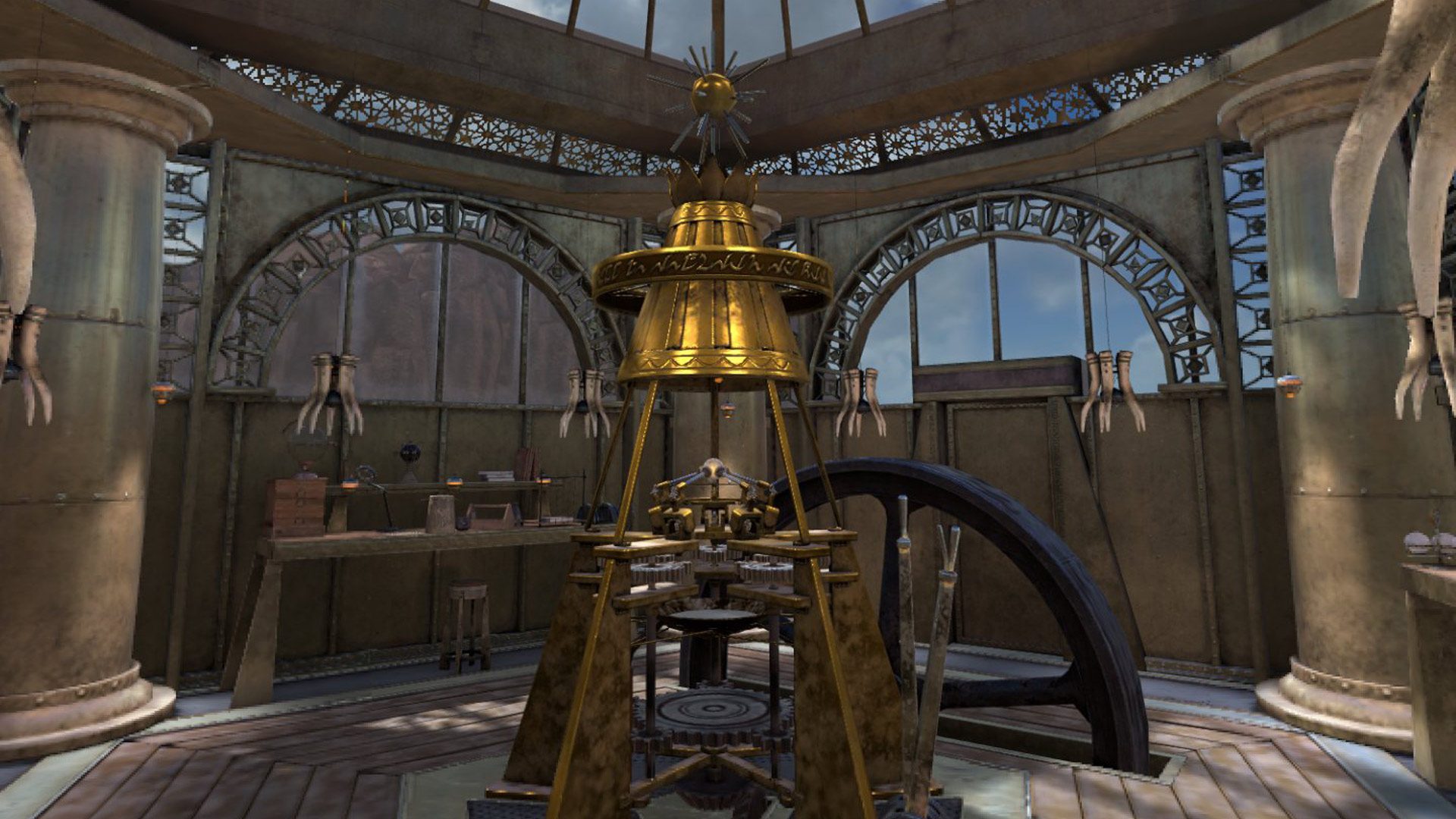
If you have played before though, many of the game’s puzzles and gadgets are slightly modified from the originals, likely due to the spatial nature of real-time 3D graphics as opposed to the single-frame point-and-click original, which was much more static in how its presented interactive elements. A 27-year-old walkthrough guide that works with the original may still be useful to help with the broad strokes, but you’ll definitely notice differences here and there, with some puzzle elements simplified, or complicated in new ways separate from the original.
One thing that hasn’t changed is there’s still a ton of walking and looping around to do, which is just a feature of the game due to its wide and varied puzzles. You’ll spend a good amount of time circumnavigating one of the game’s five islands for the umpteenth time turn on a thing, to return to a puzzle across the map to see what it did. Then again, that’s just the old school charm and hands-off approach Riven brings to the table.
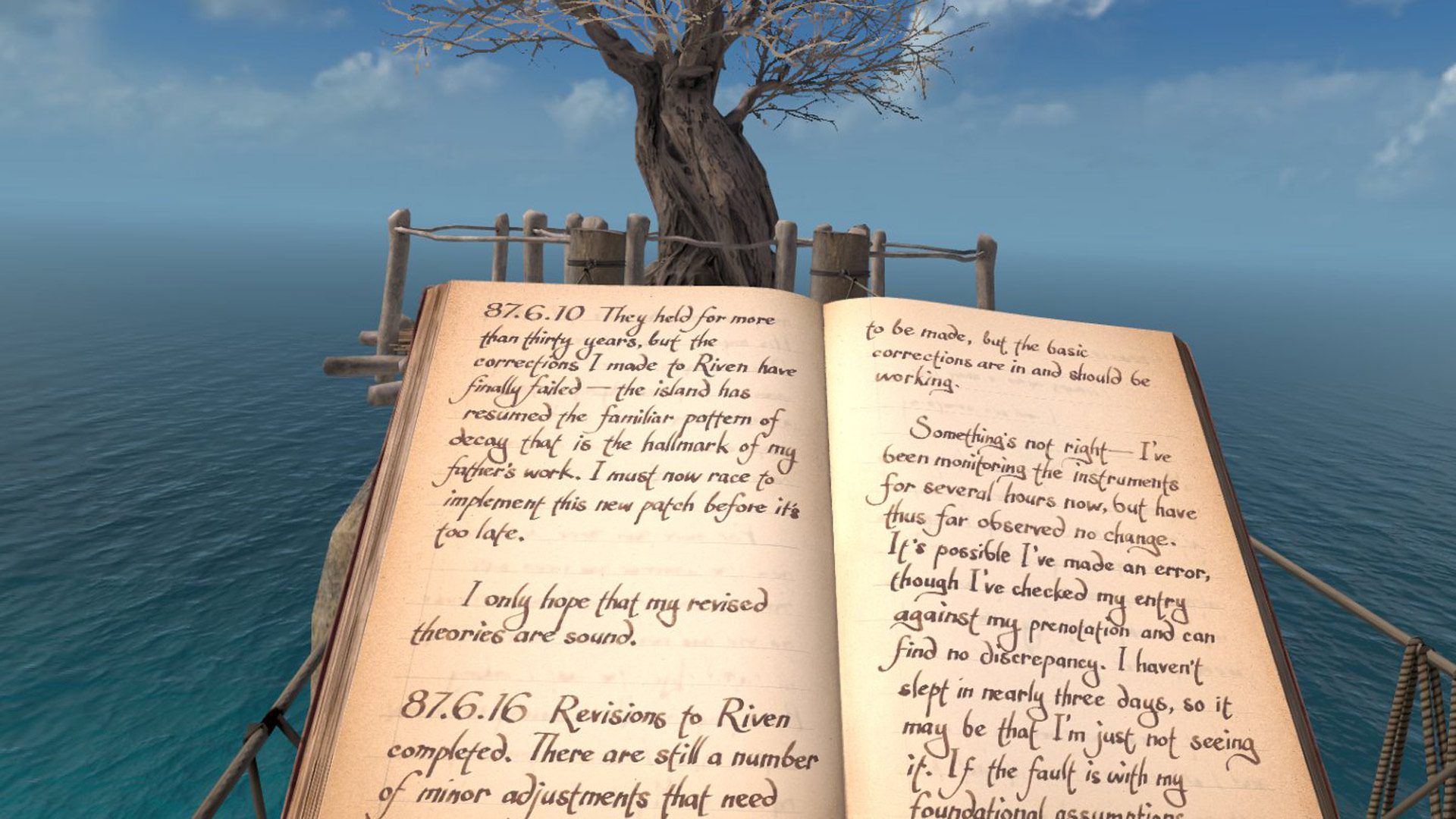
Not only that, but the old school approach to game design makes you rely upon your own spatial memory. There are no map markers, signs, or ‘helpful’ NPCs to guide your way—an aspect of the game that still makes it one of my favorite experiences.
And unlike Myst, you can go a pretty impressive distance through the game with only a few hard roadblocks to stop you, making progression feel very natural. Then again, Riven is beloved for being more organic in level design, and less formulaic than Myst overall, feeling much less like of a jumble of toys, and more like Cyan’s modern titles Obduction (2016) and Firmament (2023).
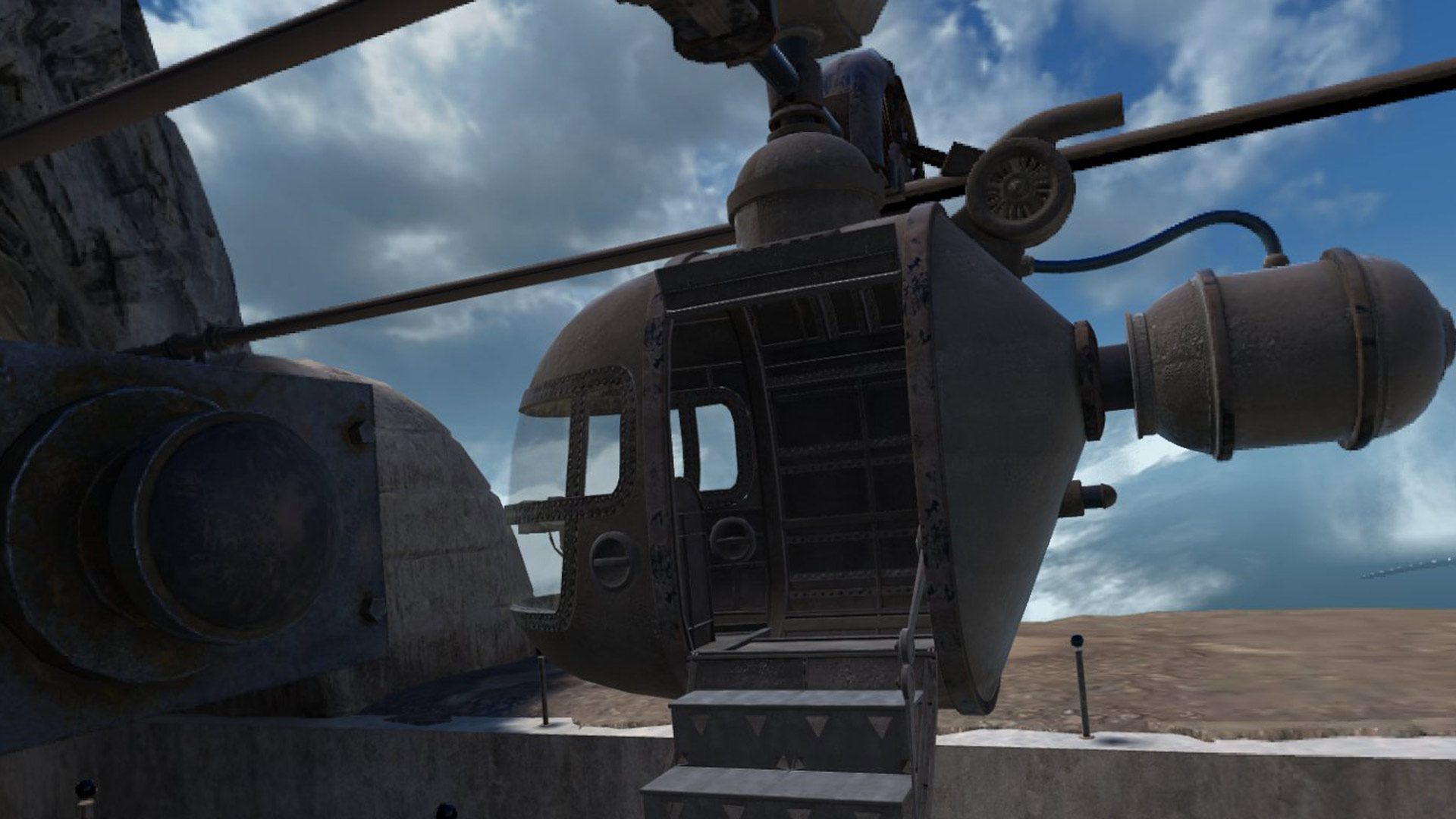
Knowing Riven’s past, I shouldn’t really complain about loading times—they’re certainly faster than shuffling through a broken jewel case filled with PS1 discs—however on Quest you’ll be sitting there for a while waiting for levels to load, the longest of which is the initial startup screen which the game warns “could take a few minutes” to do (it does). From there, whether on Quest or SteamVR, vehicle transitions will constantly toss out 10-second loading screens, which doesn’t sound like much, but happen on both sides of transfers between islands.
Another niggle: there’s no practical way to write down notes so you can remember clues or sketch out solutions, which is precisely what you’ll need to do to decode stuff. You can take a screenshot with the game’s built-in camera system, and that’s about it. I just wish there was a spatial pencil so I could annotate found letters, or somehow keep myself from taking off the headset to write stuff down.
I had a chance to play both on Quest 3 natively and PC VR versions. Here’s the breakdown between the two, which most anyone can guess.
On the Quest version you’ll notice a ton of low-res textures and geometry that dynamically chunk-loads into place the closer you get to it. Once things are in place though, at times Riven can be one of the prettiest games on the Quest platform. That’s if there aren’t any NPCs around, which are bloated and a little too cartoony for the game’s lush, natural environment.
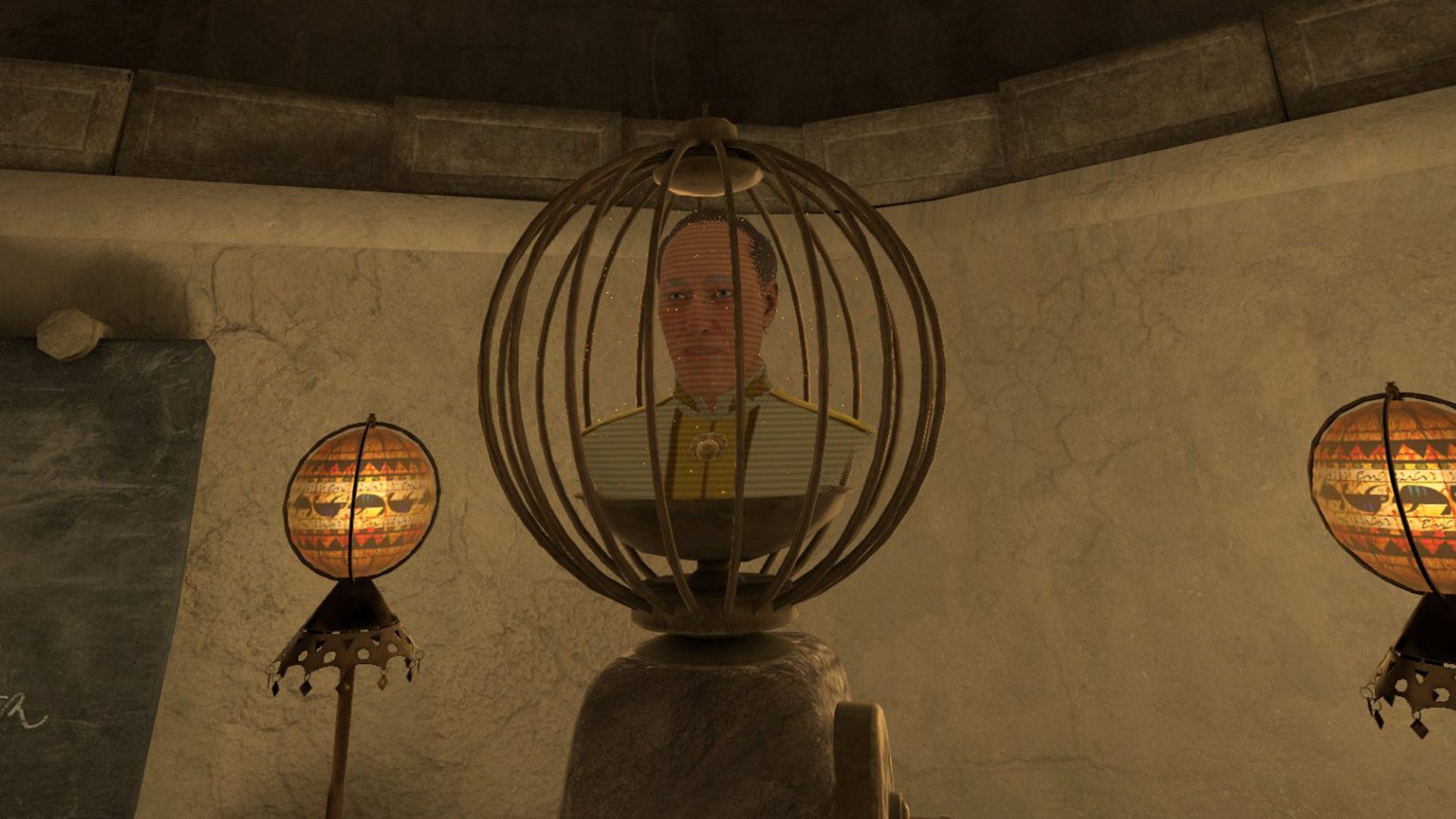
It also seems Cyan is throwing the entire toolbox of Quest performance tricks at you at all times, including what feels like always-on asynchronous spacewarp and glaringly obvious fixed foveated rendering.
Since it was primarily developed for the flatscreen PC crowd, the PC VR version is a fair bit ahead of the Quest 3 native in terms of visuals. Even on ‘Epic’ settings though, you’re bound to notice some oddly applied shaders that make shadows dance about and move when they shouldn’t, and also discrepancies in how shaders work in both eyes, leading to some pretty visible mismatches in shadows and lighting. Still. chunk-loading of areas is mostly minimal and textures are fairly high, making it rightfully a more graphically intense version of the game.
Like Myst, Riven suffers from middling object interaction, which is a shame considering how many items are strewn about in the game. Oftentimes I’d find myself trying to interact with something, only to find out I wasn’t pressing it correctly, or it wasn’t interactive at all in the first place, making it more of a guessing game than it should be. Here’s me fruitlessly grasping at a weird banana-kiwi thing, then trying to grab a strangely unusable pencil on the same table. Again, I wish I could use that damn pencil.
There is a physical inventory though where you can keep the various books you collect throughout the game, although you can’t use it for anything else.
Whether you’re on Quest or SteamVR, something that never fails to impress is coming to a precipice or turning a bend to find a new, breathtaking scene in front of you. Riven is all about natural beauty, punctuated with megalithic structures that don’t feel nearly as abandoned and lonely as Myst did.
There’s wildlife, sprawling villages, shrines, and plenty of environmental storytelling here to dig into, putting exploration at the forefront. There’s even inhabitants in the world, albeit too skittish to interact with such an obvious outsider.
Riven features the full gamut of comfort options in addition to some quality of life options that make things a little easier, but likely less immersive as a result. Traveling between islands is always done on some sort of vehicle, which can be a little jarring for some since it’s fast and a bit jerky.
You can turn vehicles transitions off entirely though, essentially letting you jump right to the next island’s rail station, or put in the option to make windows dirty, which helps ground you a little more in the vehicle’s cockpit. The game also offers similar options for instant traversal of stairs and ladders, which otherwise a manually climbable.
Check out the full comfort checklist below:
‘RIVEN’ Comfort Settings – June 25th, 2024 |
|
Turning |
|
| Artificial turning | |
| Snap-turn |  |
| Quick-turn |  |
| Smooth-turn |  |
Movement |
|
| Artificial movement | |
| Teleport-move |  |
| Dash-move |  |
| Smooth-move |  |
| Blinders |  |
| Head-based |  |
| Controller-based |  |
| Swappable movement hand |  |
Posture |
|
| Standing mode |  |
| Seated mode |  |
| Artificial crouch |  |
| Real crouch |  |
Accessibility |
|
| Subtitles | |
| Languages |
English, French, Italian, German, Japanese, Korean, Polish, Portuguese, Russian, Simplified Chinese, Spanish
|
| Dialogue audio | |
| Languages | English |
| Adjustable difficulty |  |
| Two hands required |  |
| Real crouch required |  |
| Hearing required |  |
| Adjustable player height |  |
The post ‘RIVEN’ Review – An Okay VR Port of an Awesome Game Still Worth Playing appeared first on Road to VR.
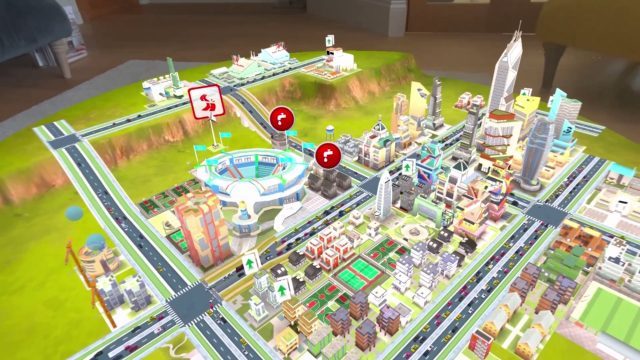
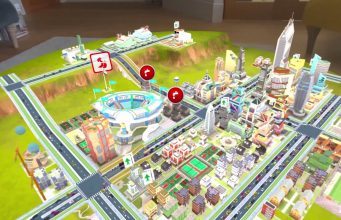
Apple Vision Pro isn’t exactly brimming with XR games yet, although starting next month you’ll be able to jump into a classic city builder that has been updated to include full mixed reality support.
Magic Fuel Games is releasing Cityscapes: Sim Builder (2023) for Vision Pro soon, bringing with it a new immersive view so you can manage your city as the god-like mayor you always wanted to be. It’s slated to arrive on July 3rd via Apple Arcade.
“They’ll use their hands to lay down roads, build neighborhoods, and ultimately grow their city into a thriving, profitable, and sustainable place to live,” Apple says in a press statement.
Cityscapes: Sim Builder has been available across all Apple devices since its initial iOS launch in mid-2023, taking the Apple Arcade Game of the Year as well as an Apple Design Award finalist.
While we still think the platform could benefit from more ports (and proper motion controllers) this follows the release of a few top mixed reality games that make use of the headset’s hand-tracking, including Game Room, WHAT THE GOLF?, Super Fruit Ninja, Where Cards Fall, Crossy Road Castle, and Solitaire Stories.
The post Vision Pro Gets Its First Native City Builder Game Next Month appeared first on Road to VR.
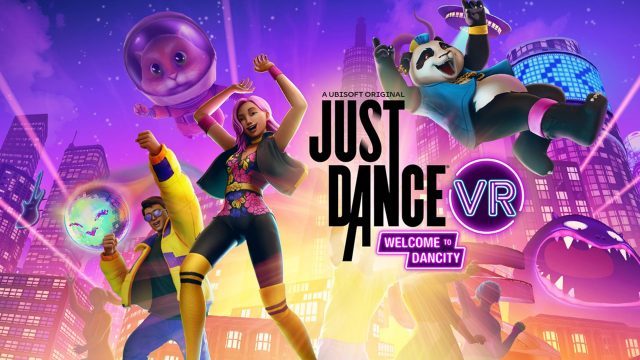
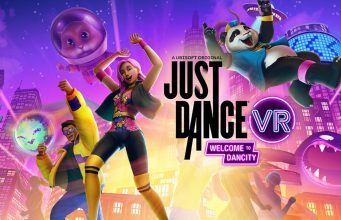
Ubisoft announced in late 2022 it was bringing a VR version of its motion-based dance game Just Dance to Pico 4, making it the first big exclusive to target what was essentially Pico’s Quest 2 competitor. Now Ubisoft has announced that Just Dance VR is coming to Quest later this year, ostensibly skipping Pico support entirely.
Pico announced during its Pico Product Announcement 2022 it was working with Ubisoft to bring Just Dance VR exclusively to Pico 4 in 2023, however it was subsequently dropped as a result of parent company ByteDance’s wide-reaching layoffs at Pico.
Now under co-development by Ubisoft Paris and Soul Assembly, Just Dance VR – Welcome to Dancity is officially coming to Quest 2/3/Pro on October 15th, where it promises to let you “dance, play basketball and interact with fun items with up to 6 players.”
Just Dance VR is set to feature a social hub called ‘Dancity’ for global dance meet ups and socializing, with the ability to setup both public and private matches. Avatars are set to be customizable, with the addition of unlockable outfits which the studio says will be powered by Ready Player Me.
At launch, Just Dance VR promises 25 chart-toppers and original songs, with a short teaser setlist shown below:
You can wishlist the game here on Quest here leading up to its release on Quest 2/3/Pro on October 15th.
The post Rhythm Game ‘Just Dance VR’ is Skipping Pico 4 Exclusivity and Launching on Quest in October appeared first on Road to VR.
Image courtesy Ubisoft
